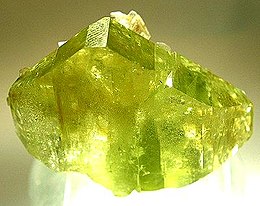| Brazilianite | |
|---|---|
 | |
| General | |
| Category | Phosphate minerals |
| Formula (repeating unit) | NaAl3(PO4)2(OH)4 sodium aluminium phosphate hydroxide |
| IMA symbol | Bzl[1] |
| Strunz classification | 8.BK.05 |
| Crystal system | Monoclinic |
| Crystal class | Prismatic (2/m) (same H-M symbol) |
| Space group | P21/n |
| Unit cell | a = 11.229 Å, b = 10.142 Å, c = 7.098 Å; β = 97.4°; Z = 4 |
| Identification | |
| Color | Yellow, green, colorless |
| Crystal habit | Prismatic crystals, may be radially-fibrous or globular druses |
| Cleavage | (010) Distinct to good |
| Fracture | Conchoidal |
| Mohs scale hardness | 5.5 |
| Luster | Vitreous |
| Streak | White |
| Diaphaneity | Transparent to translucent |
| Specific gravity | 2.98 |
| Optical properties | Biaxial (+) |
| Refractive index | nα = 1.602 nβ = 1.609 nγ = 1.621 - 1.623 |
| Birefringence | δ = 0.019 - 0.021 |
| References | [2][3] |
Brazilianite, whose name derives from its country of origin, Brazil, is a typically yellow-green phosphate mineral, most commonly found in phosphate-rich pegmatites.
It occurs in the form of perfect crystals grouped in druses, in pegmatites, and is often of precious-stone quality. One noted deposit of brazilianite is in the surroundings of Conselheiro Pena, in Minas Gerais, Brazil.
Some of these are found on leaves of muscovite with their strong silvery glitter, ingrown in their parent rock. The crystals, dark greenish-yellow to olive-green, sometimes measure up to 12 cm (4.7 in) in length and 8 cm (3.1 in) in width. Crystals of similar shape and dimensions have been discovered in another deposit in Minas Gerais, near Mantena, but they lack the perfection of the crystal form.[citation needed] Many brazilianite specimens found in mineral collections originated from the Palermo and the Charles Davis mines in Grafton County, New Hampshire.
- ^ Warr, L.N. (2021). "IMA–CNMNC approved mineral symbols". Mineralogical Magazine. 85 (3): 291–320. Bibcode:2021MinM...85..291W. doi:10.1180/mgm.2021.43. S2CID 235729616.
- ^ Brazilianite data on Webmineral
- ^ Brazilianite on Mindat.org